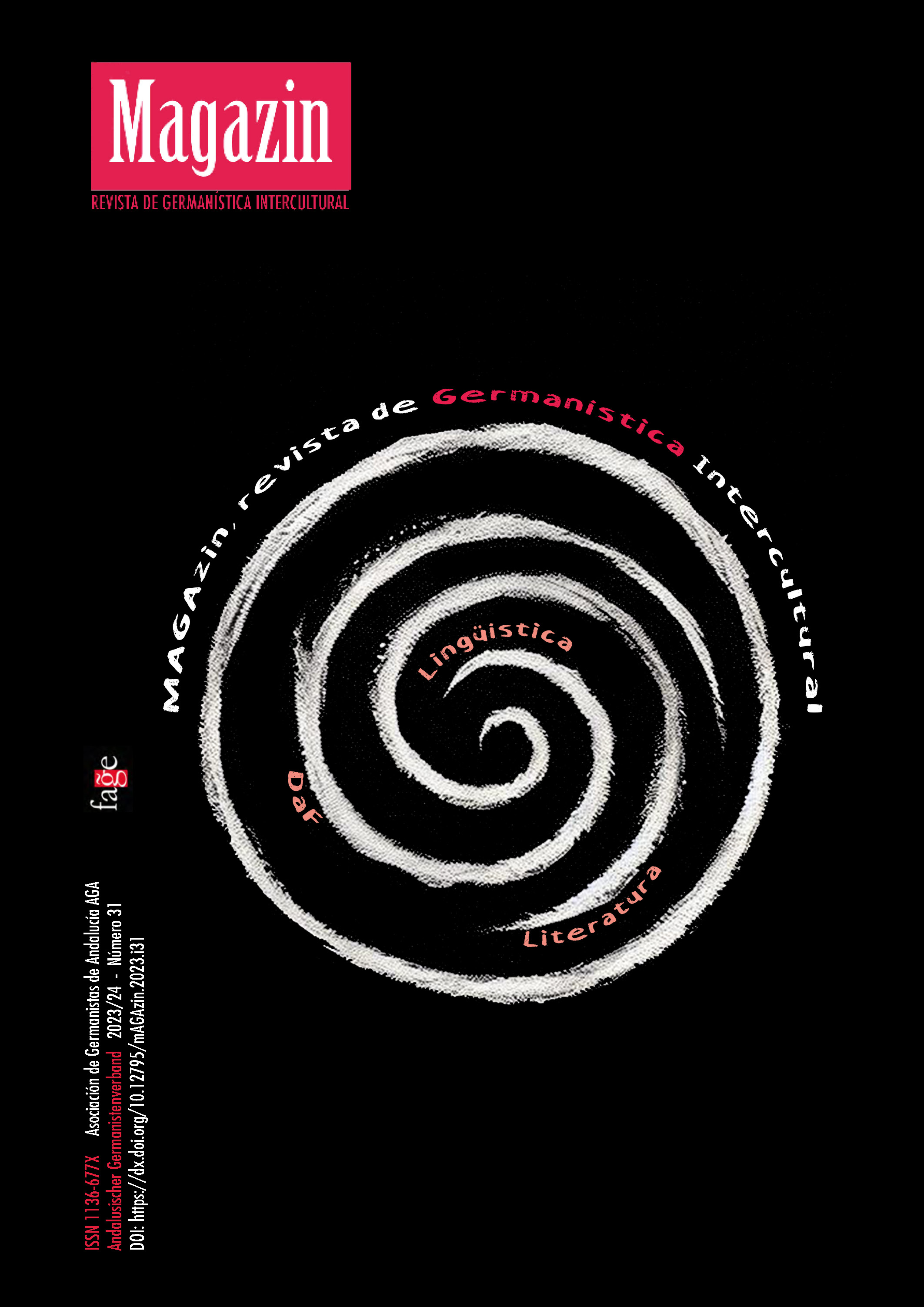Die ARAL-Tankstelle als Identifikationsraum in Herkunft, von Saša Stanišić
DOI:
https://doi.org/10.12795/mAGAzin.2023.01Palabras clave:
deutschsprachige Literatur, ex-Jugoslawien, Identität, Migration, Transkulturalität, Raum, Saša StanišićResumen
Die Migration aus den ex-jugoslawischen Ländern spielt in der heutigen deutschsprachigen Literatur eine sehr wichtige Rolle, mit renommierten Autor:innen wie Jagoda Marinić (Restaurant Dalmatia, 2013), Melinda Nadj Abonji (Schildkrötensoldat, 2017), Nicol Ljubić (Heimatroman oder Wie mein Vater ein Deutscher wurde, 2006) oder Marica Bodrožić (Kirschholz und alte Gefühle, 2014). Im Falle des Buches Herkunft (Saša Stanišić, 2019) haben junge Migranten aus unterschiedlichen Herkunft eine transkulturell dargestellte Gemeinde an einer Tankstelle gebildet. So wird eine typische nicht-Ort (Augé, 1992) bzw. Transit-Ort (Wilhelmer, 2015) in dieser Erzählung als Identifikationsraum verstanden, d.h., als unverzichtbare Bezugspunkte für die Identität der Teilnehmer dieser hybriden bzw. transkulturellen Gesellschaft. Die ARAL-Leute kann nur am Rande der herrschenden Gesellschaft ihre eigene Identität als immagined community (Anderson, 1983) entwickeln: da, wo andere nur vorbeifahren.
Descargas
Citas
Anderson, B. (1983). Imagined Communities. Reflections on the Origin and Spreadh of Nationalism ([2006]). Verso.
Aragón Ruiz-Roso, M. (2024a). ‚Erzählen Sie uns etwas’: oralidad, familia e identidad en Herkunft y Tauben fliegen auf. In M. Maldonado-Alemán (Hrsg.), Hybridität und Transkulturalität in deutschsprachigen Gegenwartsromanen / Hibridismo y transculturalidad en la narrativa actual en lengua alemana ([In press]). Peter Lang.
Aragón Ruiz-Roso, M. (2024b). Memoria de un país ausente (In press). Marcial Pons.
Assmann, A. (2006). Der lange Schatten der Vergangenheit. Erinnerungskultur und Geschichtspolitik ([2014]). C. H. Beck.
Augé, M. (1992). Non-lieux. Introduction a une anthropologie de la surmodernité. Seuil.
Bade, K. J. & Oltmer, J. (2005). Flucht und Asyl seit 1990. Bundeszentrale für politische Bildung. http://www.bpb.de/gesellschaft/migration/dossier-migration/56443/flucht-und-asyl-seit-1990
Bakić-Hayden, M. (1995). Nesting Orientalisms: The Case of Former Yugoslavia. Slavic Review, 54(4), 917–931. https://doi.org/10.2307/2501399
Bašković, A. (2013). Yugonostalgia and Yugoslav Cultural Memory: Lexicon of Yu Mythology. Slavic Review, 72(1), 54–78.
Drakulić, S. (2006). Café Europa. Life after Communism. Abacus.
González de León, M. (2018). Ab jetzt ist Ruhe? Historia, memoria e identidad en los relatos familiares de Marion Brasch, André Kubiczek y Maxim Leo. Universidad de Sevilla.
Graziano, M. (2018). What is a Border? Standford University Press.
hooks, bell. (2015). Feminist Theory: From margin to center. Routledge.
Karahasan, D. (2005). Sarajevo: Diario de un éxodo. Círculo de Lectores / Galaxia Gutenberg.
Peters, C. (2020). ‚Wirklichkeit abbilden heißt vor ihr kapitulieren’. Das Verhältnis von Fiktionalität und Faktualität in Erzähltexten von Saša Stanišić. Université de Liège.
Previšić, B. (2009). Poetik der Marginalität: Balkan Turn gefällig? In H. Schmitz (Hrsg.), Von der nationalen zur internationalen Literatur. Transkulturelle deutschsprachige Literatur und Kultur im Zeitalter globaler Migration. (S. 189–203). Rodopi.
Reyes Tovar, M. & Martínez Ruíz, D. T. (2015). La configuración identitaria en los territorios de migrantes internacionales. Península, X(2), 117–133. https://doi.org/10.1016/j.pnsla.2015.08.006
Rink, C. (2020). Wer bist du eigentlich? Saša Stanišić und das transkulturelle Einschreiben in die europäische Literaturtradition. In H. W. Giessen & C. Rink (Hrsg.), Migration, Diversität und kulturelle Identitäten (S. 195–205). J.B. Metzler. https://doi.org/10.1007/978-3-476-04372-6
Sassen, S. (2013). Inmigrantes y ciudadanos. De las migraciones masivas a la Europa fortaleza. Siglo XXI.
Sennett, R. (2015). Effiziente oder gesellige Städte? In K. Kashiwagi-Wetzel & M. Wetzel (Hrsg.), Interkulturelle Schauplätze in der Großstadt. Kulturelle Zwischenräume in amerikanischen, asiatischen und europäischen Metropolen. Wilhelm Fink.
Soja, E. (2003). Thirdspace – Die Erweiterung des Geographischen Blicks. In H. Gebhardt, P. Reuber & G. Wolkersdorfer (Hrsg.), Kulturgeographie. Aktuelle Ansätze und Entwicklungen (S. 269–288). Spektrum Akademischer Verlag.
Stanišić, S. (2019). Herkunft. Luchterhand.
Veiga, F. (2011). La fábrica de las fronteras. Guerras de secesión yugoslavas 1991-2001. Alianza.
Velasco Ortiz, M. L. (2005). Desde que tengo memoria. Narrativas de identidad en indígenas migrantes (1a). El Colegio de la Frontera Norte.
Wilhelmer, L. (2015). Transit-Orte in der Literatur. Eisenbahn – Hotel – Hafen – Flughafen. Transcript.
Descargas
Publicado
Cómo citar
Número
Sección
Licencia
Derechos de autor 2024 Manuel Aragón Ruiz-Roso

Esta obra está bajo una licencia internacional Creative Commons Atribución-NoComercial-CompartirIgual 4.0.
Política de autoarchivo
Romeo Blue Journal (en preparación)
Solo se puede archivar el PDF de editor
El autor no puede archivar la versión pre-print
El autor no puede archivar la versión post-sprint
Condiciones generales
La revista se aloja en repositorios de acceso abierto
La revista se edita en formato impreso bajo demanda y para fines promocionales y de depósito legal en un porcentaje inferior al 5%
No prevé moving wall o período de embargo
Debe utilizarse la versión de editor/PDF
La fuente editorial debe reconocerse
Creative Commons Reconocimiento-NoComercial-SinObraDerivada 4.0 Internacional





